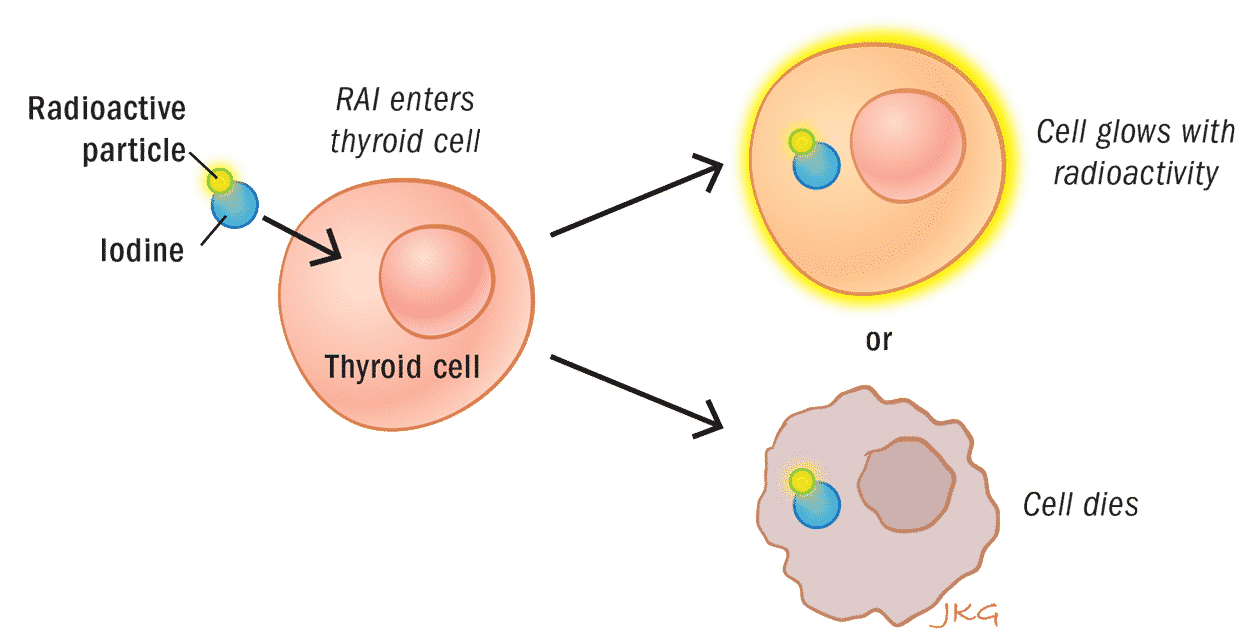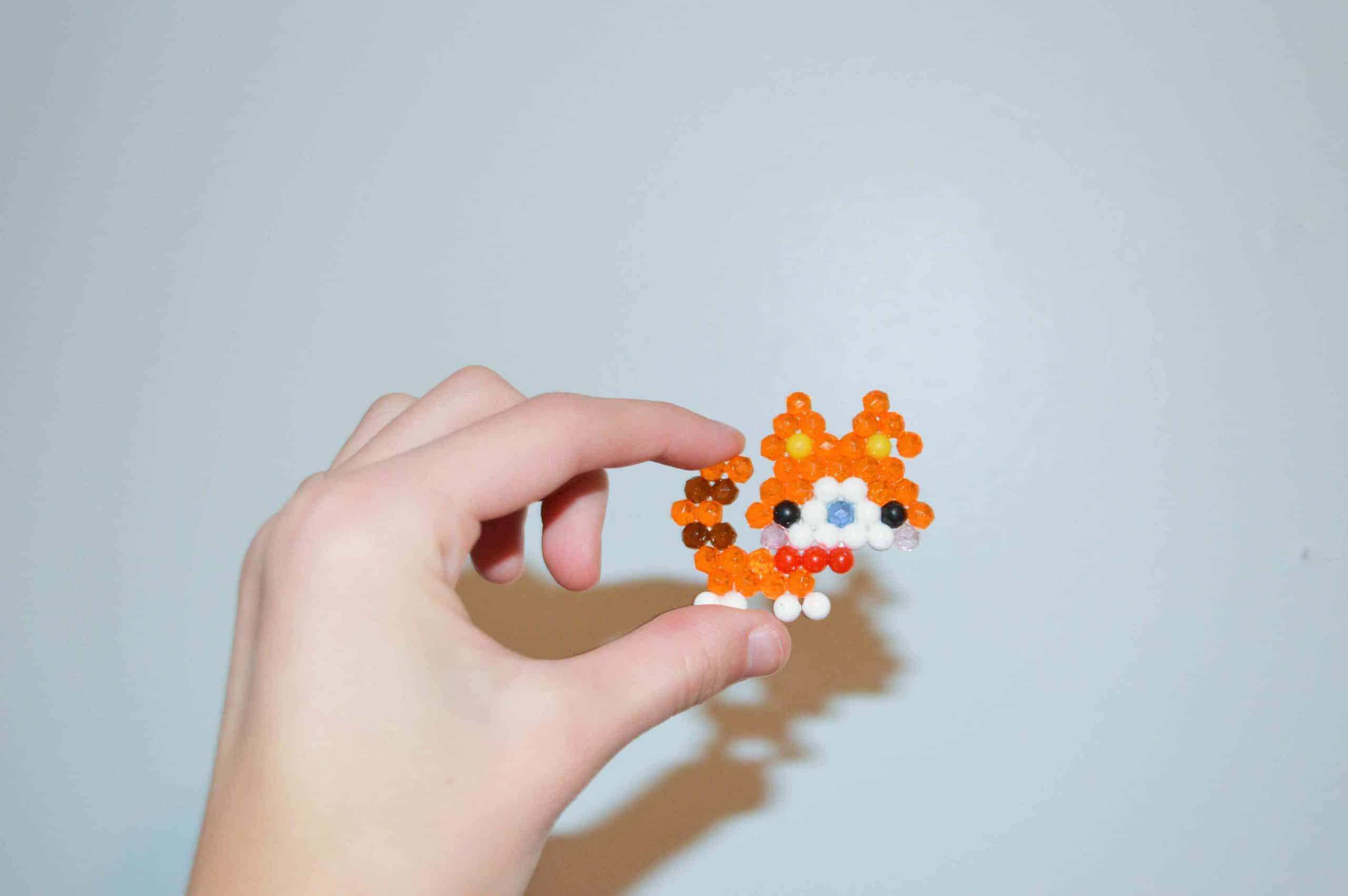Overview
The thyroid gland is made up of a special type of cells that absorb the iodine circulating in the body and use it to produce thyroid hormones. Even when affected by cancer, thyroid cells often retain this ability.
Radioactive iodine diagnostic uptake scans take advantage of the thyroid gland’s ability to concentrate iodine to help identify any residual thyroid tissue remaining after the surgical removal of the thyroid, as well as to detect potential metastatic spread to other organs. Using an orally administered type of radioactively-labeled iodine, whole body scans (WBS) are able to show where active thyroid tissue is located, aiding doctors in making treatment decisions. These scans are used in the follow-up of surgically-treated thyroid cancer patients in an effort to identify any remaining or recurrent disease.
Learn more about treating thyroid cancer with radioactive iodine.
Radioactive iodine can be used both diagnostically and therapeutically. Discover the diagnostic uses of radioactive iodine.
What are Radioactive Iodine Uptake Scans?
RAI is administered orally and is absorbed by any thyroid tissue that exists in the body. By entering thyroid cells and causing them to glow, the iodine identifies thyroid tissue that remains after surgery. It also identifies thyroid tissue present in lymph nodes in the neck and other possible spread throughout the body, even in patients without symptoms or evident masses.

When are They Used?
Radioactive iodine uptake scans are used at several key points during the treatment and follow-up of thyroid cancer patients:
- After initial total thyroidectomy surgery.
RAI uptake scans help to determine whether more treatments, such as radioactive iodine ablation (use of RAI to destroy thyroid cancer cells), will be necessary following thyroid surgery. - Several days after RAI ablation therapy.
Following RAI therapy, this will indicate whether the treatment was successful, or whether more RAI therapy is needed. - 6–12 months after the last RAI treatment.
This scan will tell doctors if the prior treatments were effective and will indicate if the thyroid cancer has spread to any new areas in the body. - As needed based on thyroid blood tests.
Blood tests will indicate levels of thyroid stimulating hormone (TSH), thyroid hormone (T4), and thyroglobulin. If the levels of these hormones are abnormal, you may have an RAI scan to ensure that the thyroid cancer has not recurred or spread. Learn more about these blood tests.
Of note, radioactive iodine scans are only effective in Well-Differentiated thyroid cancers that resemble normal thyroid tissue and absorb iodine. If the thyroid cancer cells do not absorb iodine, then the scan will not be helpful. Therefore, radioactive iodine uptake scans are not used in the management of Medullary or Anaplastic thyroid cancers, as these malignancies do not arise from normal thyroid epithelial cells and do not have the ability to absorb iodine. Additionally, some types of well-differentiated thyroid cancers may lack the ability to take up radioactive iodine, and thus these patients will not be ideal candidates for radioactive iodine uptake scans.
How to Prepare
You will consume a low-iodine diet before undergoing an RAI uptake scan. This allows thyroid cells to absorb the radioactive iodine. You must also undergo hormone stimulation, which involves increasing the levels of TSH in your blood. TSH plays a role in maintaining hormone balance and stimulating growth of thyroid tissues. It signals to the thyroid gland to absorb more iodine and produce more thyroid hormone.
To Increase TSH Levels
- Stop taking your thyroid hormone for several weeks to lower the levels of thyroid hormone in your blood. Lower thyroid hormone levels will increase the release of TSH into the bloodstream.
- Receive injected synthetic TSH to artificially increase TSH levels.
What to Expect
Once a patient has completed these preparations, he or she will be ready to receive the diagnostic dose of radioactive iodine which is administered orally.
Radioactive iodine uptake scans are performed with one of two types of radioactive iodine: I-123 or I-131. Low doses of either of these two kinds of radioactive iodine will be administered for whole body imaging.
The main difference between these two types is the length of time that they are active in the body. I-131 stays in the body for about a week, and I-123, lasts for several days. The patient’s nuclear medicine specialist will determine which kind of radioactive iodine will be used.
The scanning process is slightly different, depending on which type of radiation is selected by the nuclear medicine specialist (I-131 or I-123).
When I-131 is Selected
The patient will be asked to swallow a pill or capsule containing the iodine and then go home.
I-131 destroys thyroid cells. It stays in the body for approximately one week. 2–3 days later, you will return for a scan.
If I-123 is Selected
I-123 is armless to thyroid cells. It stays in the body for several days. Scans are taken 4–6 hours after iodine administration, and another 24 hours after iodine administration.

Download This Section
Feel free to download and print this page.
It’s free for personal use and to share with others you think might benefit from the information provided.
Safety
The usual dose of radioactive iodine for a diagnostic whole body scan is 2–5 mCi. In comparison, the dose of radioactive iodine for a therapeutic administration RAI ranges from 30 mCi to up to 200 mCi. Administration of low doses of radioactive iodine for whole body imaging has no reported side effects, nor does it carry any major risks.
Therapeutic doses of radioactive iodine are known to cause side effects such as altered sense of taste, dental cavities and tooth loss, painful swelling of the salivary glands, and secondary malignancies. Even though the doses used in whole body imaging are very small and not considered harmful, certain safety precautions should be followed.
Specific Safety Precautions
- Flush the toilet twice and wash your hands after using the bathroom, sneezing, coughing and before handling food.
- Stay more than 3 feet away from adult caregivers and more than 6 feet away from young children and pregnant women.
- Take a pregnancy test just before undergoing a RAI uptake scan if you are of childbearing age.
Do Not:
- Sleep in the same bed with other people.
- Have sexual contact.
- Share eating utensils, towels, razors, or toothbrushes with other people.











